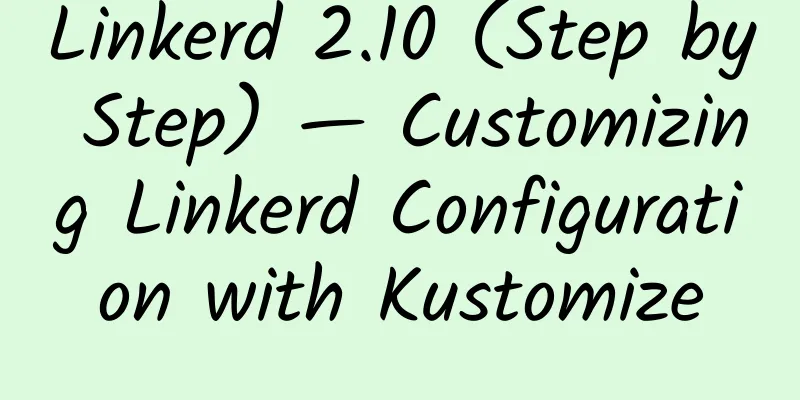Linkerd 2.10 (Step by Step) — Customizing Linkerd Configuration with Kustomize

|
The Linkerd 2.10 Chinese manual is being continuously revised and updated: https://linkerd.hacker-linner.com Kustomize can be used to patch the output of linkerd install in a consistent way, rather than forking the Linkerd installation and upgrade process. This allows installations to be customized to add installation-specific features. First, save the output of install into a YAML file. This will be the base resource that Kustomize will use to patch and generate content that is added to the cluster.
When upgrading, make sure to populate this file with the contents from linkerd upgrade . With the latest kustomize versions, this can be done automatically using the exec plugin. Next, create a kustomization.yaml file. This file will contain the instructions for Kustomize, listing the base resources and the transformations performed on those resources. Right now, this looks pretty empty:
Now, let's see how to do some example customizations. Kustomize allows any number of patches, transforms, and generators. These examples show one modification at a time, but you can make as many modifications as you want in a single kustomization.yaml file. Adding Priority ClassThere are several components in the control plane that can benefit from being associated with a critical PriorityClass. While this configuration is not currently supported as a flag to linkerd install, it is not difficult to add using Kustomize. First, create a file called priority-class.yaml, which will create a PriorityClass resource.
1000000000 is the maximum value. User defined priorities are allowed, adjust accordingly. Next, create a file called patch-priority-class.yaml which will contain the override. This override will explain what needs to be modified.
Then, add this as a strategy merge option to kustomization.yaml:
Applying this to your cluster requires taking the output of kustomize build and piping it to kubectl apply. For example, you could run:
Modify Grafana configurationInterested in enabling authentication for Grafana? You can do this with a one-time modification to the ConfigMap. Unfortunately, these changes will eventually be reverted every time a linkerd upgrade occurs. Instead, create a file called grafana.yaml and add your modifications:
Then, add this as a strategy merge option to kustomization.yaml:
Finally, apply it to your cluster by generating the YAML using kustomize build and piping the output to kubectl apply .
【Editor's recommendation】
|
>>: Why are operators competing to launch new 4G packages as 5G is the mainstream?
Recommend
Ruijie helps Sichuan Light Industry and Chemical Industry build an Ethernet all-optical campus network to accelerate the development of new education infrastructure
When it comes to smart campus construction and ed...
When it comes to data transmission, 5G is just the beginning
If there’s a technology that’s tailor-made for th...
MoonVM: Hong Kong high-bandwidth VPS monthly payment starting from $10.8, 1GB memory/10G SSD/5TB monthly traffic
The tribe once shared information about MoonVM in...
From Wi-Fi to Wired: Exploring the Role of Cable in Wireless Networks
In an increasingly connected world, wireless netw...
Mathematical formula could help 5G networks share communication frequencies efficiently
Researchers at the National Institute of Standard...
spinservers VPS 50% off in July, San Jose 2G memory package starts at $7/month, optional mainland optimized network
spinservers is offering a 50% discount coupon for...
RackNerd: Multi-room AMD Ryzen+DDR4+NVMe series VPS is available for purchase starting at $14.18 per year
RackNerd is a foreign hosting company founded in ...
Cisco fully opens a new era of smart office
Technology has revolutionized the human work expe...
How to deal with the new security challenges brought by 5G
Mobile network infrastructure has changed dramati...
HostKvm New Year Offer: Hong Kong Cloud 4G Memory Package Annual Payment Discount Only $60/Year
HostKvm is a foreign VPS service provider founded...
Urgent reminder: DediPath officially announced to run away
We have received the official announcement from D...
How do terminals in a LAN access the external network? The answer is at the end
[[357957]] 0. Fans Questions Fans asked: "Ho...
What changes will the integration of 5G and the Internet of Things bring?
The convergence of 5G and the Internet of Things ...
The United States has approved 6G trials. Is this a far-sighted move or a desperate attempt?
Recently, US President Trump announced the approv...
![[Black Friday] Hostodo: $13.99/year-512MB/16G NVMe/3TB/Las Vegas & Spokane & Miami Data Center](/upload/images/67cac0126520b.webp)








